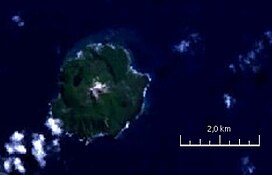Fonualei
| Fonualei | |
|---|---|
 image of Fonualei Island, northern Tonga, Pacific Ocean | |
| Highest point | |
| Elevation | 188 m (617 ft)[1] |
| Listing | List of volcanoes in Tonga |
| Coordinates | 18°01′26″S 174°19′30″W / 18.024°S 174.325°W |
| Geography | |
 | |
| Location | Tonga Islands |
| Geology | |
| Mountain type | Stratovolcano |
| Last eruption | June 1957 |
Fonualei is an uninhabited volcanic island in the kingdom of Tonga. It 70 km northwest of Vavaʻu and is part of the highly active Kermadec-Tonga subduction zone and its associated volcanic arc, which extends from New Zealand north-northeast to Fiji, and is formed by the subduction of the Pacific Plate under the Indo-Australian Plate.[2] The closest island to Fonualei is Tokū 19.7 km to the southeast.
Geography
[edit]The island is the peak of an active volcano which rises 1000m from the seafloor.[3] It has a diameter of 2 km and a maximum height of 188m.[1] The coast is surrounded by cliffs, with only two beaches suitable for a landing.[3] The western, southern, and north-eastern sides have narrow fringing reefs.[3]
History
[edit]In the 1830s the inhabitants of Tokū used Fonualei for their gardens.[4]: 4
The first European to sight the island was Don Francisco Mourelle de la Rua on the La Princesa on 26 February 1781.[5] He reported the island to be barren from eruptions, and called it for that reason Amargura (Bitterness in Spanish).[6] It was subsequently seen by La Pérouse on 27 December 1787, and by HMS Pandora during its hunt for the Bounty mutineers, who named it "Gardner’s Island".[4]: 4
A major eruption in 1846, starting 11 June, destroyed much of the vegetation of Vavaʻu and spread ash around for at least a year. Some sources claim that three other neighbouring volcanoes, Late, Tokū and another, erupted at the same time. This is probably a mistake by passing ships who misidentified the erupting island. Another eruption was reported in July 1938.[7]
In the 1980s the island was leased for 30 years to the Chen family as part of a scheme to sell Tongan passports to wealthy foreigners.[8][9]
In September 2022 scientists mapping marine life noted discolouration in the water near the island and emissions of sulphuric gases.[10]
Ecology
[edit]The island has been designated an Important Bird Area by BirdLife International.[11] It is home to a large colony of Sooty terns.[11] Other birds found on the island include the Tongan ground dove, Pacific imperial pigeon, Spotless crake, Australasian swamphen, Polynesian wattled honeyeater, and Polynesian starling.[12]: 9 Sea- and shorebirds include the brown and red-footed Booby, the great and Lesser frigatebird, White tern, Red-tailed tropicbird, the black and brown Noddy, Pacific golden plover, and Bristle-thighed curlew.[12]: 9 The only land-based mammal is the Insular flying fox.[12]: 9 The island is rat-free.[12]: 12
In 1993 Fonualei was assessed as a potential habitat for the critically endangered Tongan megapode.[13] 70 eggs and 10 chicks were translocated.[14] The introduction was successful, and in 2003 the population was estimated at 300 to 500 birds.[14] In 2013 it was estimated at 600 to 1,000 adults.[12]: 13
See also
[edit]References
[edit]- ^ a b "Fonualei". Global Volcanism Program. Smithsonian Institution. Retrieved 22 January 2022.
- ^ Turner, Simon; Caulfield, John; Rushmer, Tracy; Turner, Michael; Cronin, Shane; Smith, Ian; Handley, Heather (June 2012). "Magma Evolution in the Primitive, Intra-oceanic Tonga Arc: Rapid Petrogenesis of Dacites at Fonualei Volcano". Journal of Petrology. 53 (6): 1231–1253. doi:10.1093/petrology/egs005.
- ^ a b c Brodie, J. W. (1970). "Notes on volcanic activity at Fonualei, Tonga". New Zealand Journal of Geology and Geophysics. 13 (1): 30–38. Bibcode:1970NZJGG..13...30B. doi:10.1080/00288306.1970.10428204.
- ^ a b Spennemann, Dirk HR (2004). "The June 1846 Eruption of Fonualei Volcano, Tonga: An Historical Analysis" (PDF). Albury, NSW: Johnstone Centre. Retrieved 22 January 2022.
- ^ Sharp, Andrew, The discovery of the Pacific Islands Oxford 1960, p.149
- ^ "CAPTAIN COOK MET A LIAR SO VAVA'U 'FELL' TO A WEARY SPANIARD". Pacific Islands Monthly. Vol. 44, no. 10. 1 October 1973. p. 49. Retrieved 22 January 2022 – via National Library of Australia.
- ^ "ERUPTION ON ISLAND". The Sun. Sydney. 14 July 1938. p. 9. Retrieved 22 January 2022 – via National Library of Australia.
- ^ "Stormin' Pohiva fights on". Pacific Islands Monthly. Vol. 61, no. 4. 1 April 1991. p. 14. Retrieved 22 January 2022 – via National Library of Australia.
- ^ "Tonga's passport controversy". Pacific Islands Monthly. Vol. 52, no. 1. 1 January 1981. p. 36. Retrieved 22 January 2022 – via National Library of Australia.
- ^ Kalino Latu (5 September 2022). "Fonualei recent volcanic activities spark fears of possible eruptions, tsunami that could affect the whole of Vava'u". Kaniva Tonga. Retrieved 5 September 2022.
- ^ a b "Fonualei : Summary". BirdLife International. Retrieved 22 January 2022.
- ^ a b c d e David J. Butler (September 2013). BIRD SURVEYS OF LATE AND FONUALEI ISLANDS, VAVA'U, KINGDOM OF TONGA (PDF) (Report). SPREP. Retrieved 22 January 2022.
- ^ "Refugees on remote volcanoes". Pacific Islands Monthly. Vol. 63, no. 4. 1 April 1993. pp. 34–35. Retrieved 22 January 2022 – via National Library of Australia.
- ^ a b "Megapodes alive and well on Fonualei". Guardian. 24 July 2003. Retrieved 22 January 2022.
- D. Gerstle; Gentle people, into the heart of Vavaʻu 1781–1973; Tofua press 1973
